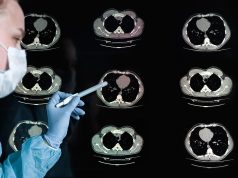The 101st Scientific Assembly and Annual Meeting of the Radiological Society of North America
The annual meeting of the Radiological Society of North America was held from Nov. 29 to Dec. 4 in Chicago and attracted approximately 55,000 participants from around the world, including radiologists, radiation oncologists, physicists in medicine, radiologic technologists, and other health care professionals. The conference featured scientific papers in a number of subspecialties covering the newest trends in radiological research as well as highlighted education and informatics exhibits.
In one study, Hazel Zonneveld, M.D., of the Erasmus University Medical Center in Rotterdam, Netherlands, and colleagues found that in community-dwelling middle-aged and elderly persons, subclinical cardiac dysfunction as reflected by serum N-terminal pro b-type natriuretic peptide levels, is cross-sectionally associated with global and microstructural imaging markers of subclinical vascular brain disease.
“This suggests that the heart-brain connection may already be present in a subclinical phase without overt heart disease and brain disease,” Zonneveld said. “This research is a step towards a better understanding of how heart disease and brain disease are linked. Further research is needed to elucidate the potential causal relationship between cardiac dysfunction and subclinical brain disease, and to explore the prevailing pathway among several hypotheses.”
In another study, Rajesh Krishnamurthy, M.D., of the Texas Children’s Hospital in Houston, and colleagues highlighted the critical role of radiology in surgical planning and surgical simulation. The investigators discussed the successful separation of conjoined twins fused at the chest, abdomen, and pelvis. The surgical team used a unique technique of imaging the twins with target mode electrocardiogram-gated computed tomography (CT) and individual CT angiograms, creating a composite model of the body. In addition, the team also used three-dimensional (3D) modeling and 3D printing to develop a representation of the surgically relevant viscera and vasculature in a single 3D printed model.
“Biomodeling and 3D printing will influence the way complex surgeries are performed in the future,” Krishnamurthy said. “They will also enhance communication between multidisciplinary care teams, patients, and patient families.”
In a feasibility study, Steven Don, M.D., of the Washington University School of Medicine in St. Louis, and colleagues found that a new software developed for Microsoft Kinect can empower technologists with the information they need to take the best radiographs at the appropriate dose for each patient.
“This feasibility shows that one may be able to use the Microsoft Kinect system and our proprietary software to optimize radiation exposure by setting thickness-based exposures rather than age-based exposures,” Don said. “It can also confirm that the correct body part is being imaged and reduce repeat rates by identifying potential problems before the radiograph is taken, including positioning, motion, and clipped anatomy.”
Phillip Boiselle, M.D., of the Beth Israel Deaconess Medical Center and Harvard Medical School in Boston, and colleagues found that women in the National Lung Screening Trial were 50 percent more likely than men to have a particular lung nodule consistency (ground glass), and such women were also at a significantly higher risk of developing a lung cancer than men with the same type of lung nodules.
“Patient sex influences the relative risk of lung cancer for a specific type of lung nodule. Taken together with recent evidence showing that women have a greater mortality benefit from CT screening for lung cancer than men, and that this test is more cost-effective for women than for men, greater emphasis needs to be placed on educating women and their health care providers about the potential benefits of CT screening for women at high risk for lung cancer who meet eligibility criteria,” Boiselle said. “These findings will influence ongoing and future studies looking more carefully at lung cancers occurring in women with ground-glass lung nodules, specifically with respect to their influence on lung cancer mortality. Such investigations may lead to sex-specific guidelines to ensure appropriate follow-up of women at increased risk for lung cancer with this subtype of lung nodule.”
RSNA: Patient Mood During Procedures May Affect Outcomes
THURSDAY, Dec. 3, 2015 (HealthDay News) — A patient’s mood while undergoing a medical procedure can affect the results, a new study suggests. The findings were scheduled to be presented at the annual meeting of the Radiological Society of North America, held from Nov. 29 to Dec. 4 in Chicago.
RSNA: Importance of Breast Density in Cancer Risk Questioned
WEDNESDAY, Dec. 2, 2015 (HealthDay News) — Breast density is considered by many an independent risk factor for breast cancer. But new research from Croatia suggests it might not be that critical after all. The findings were scheduled to be presented at the annual meeting of the Radiological Society of North America, held from Nov. 29 to Dec. 4 in Chicago.
RSNA: Reduced Blood Flow in Brain Persists Post Concussion
TUESDAY, Dec. 1, 2015 (HealthDay News) — Athletes who suffer a concussion can show signs of reduced cerebral blood flow, even after their symptoms have subsided, a new, preliminary study suggests. The findings were scheduled to be presented at the annual meeting of the Radiological Society of North America, held from Nov. 29 to Dec. 4 in Chicago.
RSNA: Breast Cancer Screening Among Poor Up Post ACA
TUESDAY, Dec. 1, 2015 (HealthDay News) — More low-income women are being screened for breast cancer due to expanded Medicaid coverage under the Affordable Care Act, according to a new study. The findings are scheduled to be presented at the annual meeting of the Radiological Society of North America, held from Nov. 29 to Dec. 4 in Chicago.
RSNA: Knee Cartilage Can Regenerate in Distance Runners
TUESDAY, Dec. 1, 2015 (HealthDay News) — Runners who run very long distances suffer cartilage damage in their lower joints — but the cartilage can regenerate, a small study suggests. The findings are scheduled to be presented at the annual meeting of the Radiological Society of North America, held from Nov. 29 to Dec. 4 in Chicago.
RSNA: Losing >10 Percent of Body Weight Can Protect Knees
TUESDAY, Dec. 1, 2015 (HealthDay News) — Losing a large amount of weight slows the loss of knee cartilage in obese people, according to a study scheduled to be presented at the annual meeting of the Radiological Society of North America, held from Nov. 29 to Dec. 4 in Chicago.
Copyright © 2015 HealthDay. All rights reserved.







